Understanding the Lunar Phases: A Complete Guide
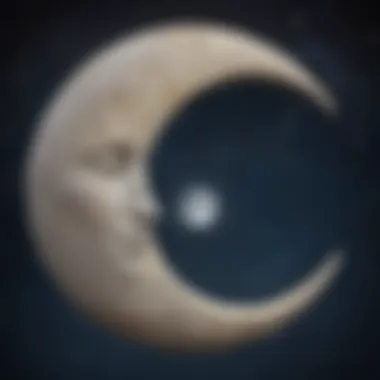
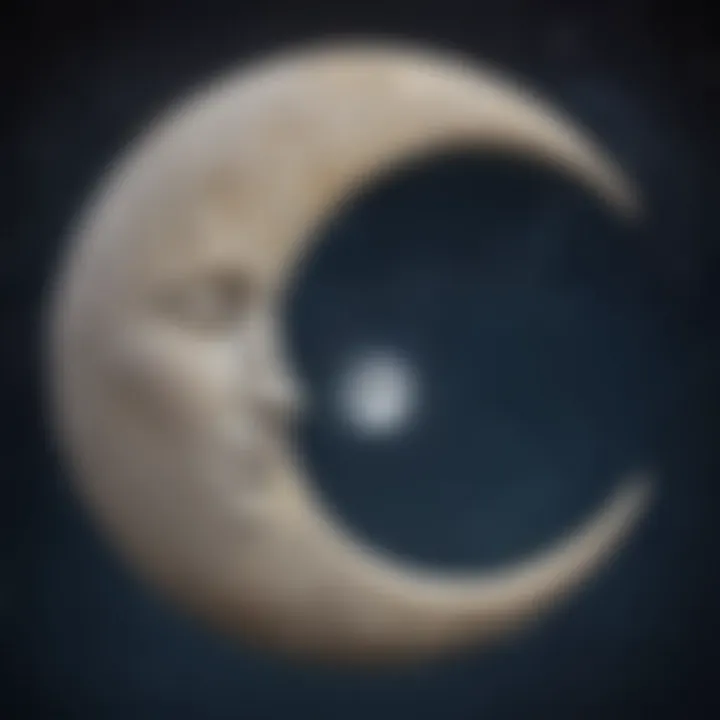
Intro
The moon is a fascinating and ever-changing celestial body that has intrigued humanity for centuries. Its phases mark the passage of time and influence various aspects of life on Earth. Understanding the moon's phases not only broadens our knowledge of astronomy but also connects us with the natural world. This article will guide readers through each phase of the moon, explaining its characteristics and significance.
Science Fun Facts
The moon is more than just a glowing object in the night sky. It has interesting traits and influences that have captured the minds of scientists and philosophers alike.
Interesting Trivia and Facts
- The moon is about 238,855 miles away from Earth.
- It takes the moon about 27.3 days to complete one orbit around Earth.
- The surface temperature on the moon can swing between extremely hot and extremely cold, with daytime highs reaching up to 253°F (123°C) and nighttime lows dropping to -387°F (-233°C).
- The moon has no atmosphere, so there is no sound in the vacuum of space where it resides.
- Each month, we can see about 50% of the moon’s surface at any time, even though it appears to change form.
Quirky Science Stories
Historically, the moon has inspired countless myths and stories across cultures. For example, ancient Greeks believed the moon was a goddess named Selene, who rode across the sky in a chariot. In other cultures, the moon is viewed as a powerful symbol of fertility and abundance.
Discover the Wonders of Science
Engaging with the science of the moon can take many forms, from educational videos to fun interactive tools.
Exploring Various Scientific Concepts
The lunar phases arise from the changing angles between the Earth, moon, and sun. This arrangement allows observers on Earth to see various portions of the moon illuminated by sunlight.
Educational Videos and Animations
Visual learning aids can enhance understanding of lunar phases. Resources such as NASA's website offer educational videos on lunar science tailored for young audiences.
Interactive Learning Tools
There are many apps and websites for tracking the lunar phases. These tools can be useful in recognizing the changes in the moon day by day.
Real-Life Applications of Science
The moon's cycles have implications for tides and natural events on Earth. They are essential for activities in agriculture, fishing, and even some religious calendars.
Science Quiz Time
Testing knowledge through interactive quizzes can help reinforce understanding of the moon's phases.
Interactive Quizzes
- Question 1: How long does it take the moon to orbit Earth?
- Question 2: What phase comes after the New Moon?
- A) 14 days
- B) 27.3 days
- C) 30 days
- A) Full Moon
- B) Waxing Crescent
- C) Waning Crescent
Brain Teasers and Puzzles
- Create a moon phase chart. Fill in the names of the phases as you learn about each one!
Science Experiment Showcase
Hands-on activities can make science more appealing and help tough concepts stick.
Fun and Engaging Experiments
- Objective: Understand the lunar phases using a simple ball and a light source.
Materials List
- A small ball (to represent the moon)
- A lamp (to represent the sun)
- A dark room
Step-by-Step Instructions
- Turn on the lamp and place it in the center of the room.
- Stand a few feet away and hold the ball in front of the lamp.
- Observe how the brightness of the ball changes as you move it around the light source.
- Note how different angles create various "phases" of the moon.
Safety Tips and Precautions
- Be careful with the lamp to avoid burns.
- Ensure the area is safe by not having any flammable items nearby.
Understanding the phases of the moon opens windows to science and nature, enriching our view of the world around us.
Prologue to the Moon's Phases
The phases of the Moon play a significant role in both our daily lives and the broader natural world. This section aims to lay the groundwork for understanding how the Moon transitions through its different visual stages. The importance lie not only in the aesthetics but also in how these cycles impact various aspects of Earth, such as tides and animal behavior.
What Are the Moon's Phases?
Moon phases are the different stages that the Moon goes through in its cycle. Borrowing from the perspectives of both science and culture, these phases are determined by the relative positions of the Earth, Moon, and Sun. As the Moon orbits the Earth, we observe varying amounts of its illuminated surface from our vantage point. These include stages such as the New Moon, Full Moon, and several crescents and gibbous phases in between.
The cycle lasts approximately 29.5 days, resulting in a sequence that is well-known in many cultures. Each phase presents unique characteristics, enriching our understanding of this celestial body.
The Importance of the Lunar Cycle
The lunar cycle is not merely a series of visual phenomena; it serves multiple practical purposes. Primarily, it influences Earth's tides due to the gravitational pull exerted by the Moon. Understanding of this cycle gains relevance in fields like agriculture, where planting and harvesting are often aligned with specific phases for optimization.
Furthermore, the lunar cycle affects some animals' behaviors, such as mating and migration patterns. In essence, the Moon's phases provide a rhythm to life on Earth, reminding us of our connections to larger cosmic cycles. Scientists and casual observers alike find value in recognizing the lunar phases' significance in the natural world.
"The Moon phases are a reflection of the universe's rhythmic dance. They are not just appearances; they influence various elements of life on Earth."
By delving deeper into the specifics of each phase, we prepare to explore their characteristics and cultural significance, which will illuminate the complexities surrounding this fascinating celestial phenomena.
The New Moon Phase
The New Moon phase is a significant part of the lunar cycle. During this phase, the moon is positioned between the Earth and the Sun, which makes it invisible from our viewpoint. This obscured state is crucial for various reasons. The New Moon phase marks the start of a new cycle, signifying new beginnings. It is a time when people often set intentions and make plans for the future. Understanding the New Moon can enhance one's connection to nature and celestial events.
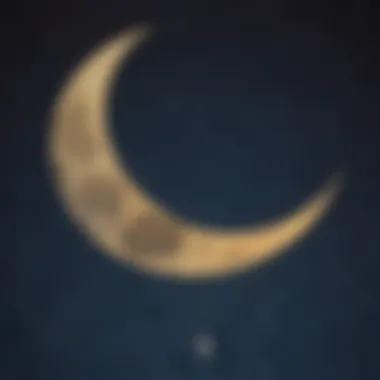
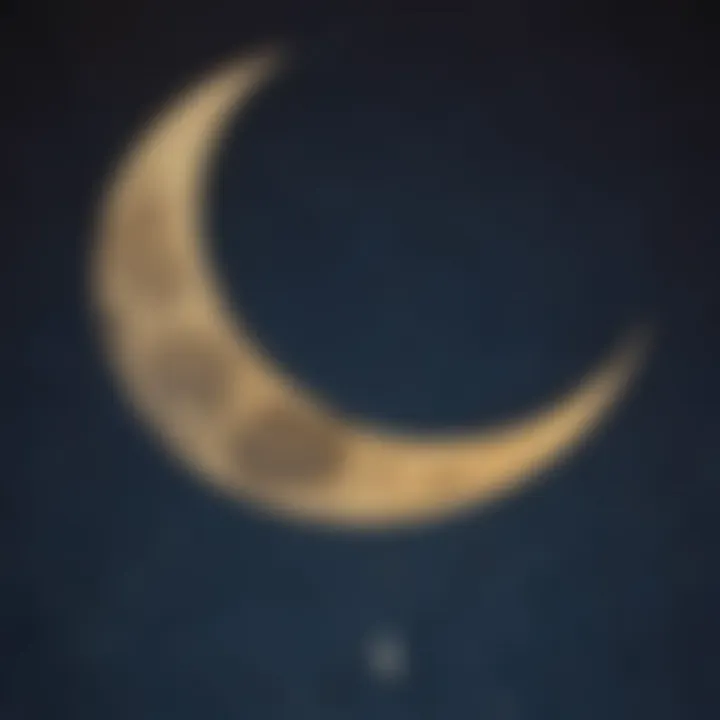
Characteristics of the New Moon
The New Moon is characterized by its complete darkness and unique positioning. Here are some key features:
- Lack of Illumination: The moon does not reflect sunlight, making it difficult to see.
- Orbital Position: It occurs when the moon aligns with the Earth and Sun.
- Duration: This phase lasts for about one day but is essential to the entire lunar cycle.
Visibility of the New Moon takes place only during very special conditions, such as a solar eclipse. Most often, this phase slips by unnoticed.
Cultural Significance of the New Moon
Around the world, the New Moon holds considerable cultural meaning. Many traditions celebrate this phase in various ways:
- Cultural Rituals: In some cultures, rituals are performed to honor new beginnings. This includes meditation, reflection, and goal-setting.
- Agricultural Practices: Farmers use the lunar cycle for planting and harvesting, believing that the New Moon brings fertile conditions.
- Spiritual Insights: Many believe that the New Moon is a powerful time for spiritual practices, inviting change and transformation.
"The New Moon represents a blank slate and a chance to reset one's intentions."
In summary, the New Moon phase is not just a darkened sky; it provides an opportunity for introspection and planning ahead. Its relevance stretches from personal growth to cultural traditions.
The Waxing Crescent Moon
The Waxing Crescent Moon marks a beautiful phase in the lunar cycle. This period occurs after the New Moon. It indicates that the illuminated portion of the Moon is increasing. Observing the waxing crescent is both exciting and informative. It invites curiosity about how our lunar neighbor evolves. Understanding this phase is vital since it connects the start of the lunar month to the bright and visible Full Moon.
Visual Features of the Waxing Crescent
When you look up at the sky during the Waxing Crescent phase, what you see is a thin sliver of light. This crescent shape gradually expands over time. The light is often described as soft and delicate. The shape results from the sunlight reflecting off the Moon's surface at an angle. It typically appears in the western sky after sunset.
During this phase, the Moon can range from 1% to 49% illuminated. It depends on the alignment of the Earth, Moon, and Sun. As the days progress, the crescent grows wider. You might notice that more details of the lunar surface become visible, like the craters and valleys, particularly just before it reaches the First Quarter stage.
Symbolism of the Waxing Crescent
Many cultures attribute various meanings to the Waxing Crescent Moon. It often symbolizes new beginnings and growth. When people see this phase, it evokes feelings of hope and optimism for what is to come.
The waxing crescent is a time for setting intentions. People believe it is perfect for starting fresh projects or activities. It signifies a time to build upon new ideas. Often, this phase is associated with renewal. It prompts individuals to reflect on what they want to achieve in the coming month.
- Common symbols and meanings include:
- Renewal
- Growth
- Intention-setting
Learning about the Waxing Crescent Moon is beneficial. It helps foster an appreciation for the natural world's cycles. By understanding it, both children and adults can connect more deeply with astronomy.
The First Quarter Moon
The First Quarter Moon plays a significant role in understanding the lunar cycle. This phase occurs approximately a week after the New Moon and is one of the eight distinct phases of the moon. During this time, half of the moon is illuminated, creating a striking visual that many people enjoy watching. The importance of the First Quarter Moon extends beyond its appearance; it signifies a period of balance and transformation. This balance is seen both physically, in the moon's lighting, and metaphorically, as it represents a turning point in both life and nature.
Understanding the First Quarter
The First Quarter Moon is characterized by its half-lit appearance. This illumination occurs because the Earth is positioned between the sun and the moon, with half of the moon facing the sun receiving direct light. The other half remains in shadow, creating what looks like a clean half-circle from the Earth’s perspective.
This phase lasts for about three and a half days. During this time, the moon is in a position where it is easily visible in the sky during the evening. As it continues its orbit, it leads into the Waxing Gibbous phase where we see more illumination.
The First Quarter Moon does not only serve as a visual marker. It is often associated with growth and development. For many, this phase is seen as a time to set intentions and goals based on what was initiated during the New Moon phase. This symbolic aspect helps people to reflect upon their aspirations and aspirations, increasing their potential for success.
Common Misconceptions About the First Quarter
Despite its importance, several misconceptions exist about the First Quarter Moon. One common misunderstanding is that the term "First Quarter" implies that only one-fourth of the moon is visible. In reality, during this phase, exactly half of the moon is illuminated. This confusion arises due to the term
The Waxing Gibbous Moon
The Waxing Gibbous Moon is a fascinating phase in the lunar cycle. It occurs after the First Quarter and before the Full Moon. During this time, more than half of the moon's visible surface is illuminated. This phase is significant for several reasons, both in terms of observation and cultural beliefs.
Identification of the Waxing Gibbous
Identifying the Waxing Gibbous Moon is quite simple. The moon appears almost round, with just a small section of the dark side visible. The illuminated part continues to grow, progressing towards a Full Moon. To see the Waxing Gibbous, look for the moon in the evening sky. It usually rises in the east around midday and sets in the west around midnight.
A few tips for identification include:
- Appearance: The moon is nearly full but not fully illuminated.
- Brightness: This moon phase is bright and easy to spot against the night sky.
- Timing: It occurs about one to two days before the Full Moon.
Astrological Views on Waxing Gibbous
In astrology, the Waxing Gibbous Moon holds special significance. Astrologers believe that this phase is associated with growth and development. It symbolizes the peak of energy and the building of potential. Many people use this time for setting goals and making plans. This phase encourages introspection, allowing individuals to assess their progress.
Some common astrological beliefs include:
- Growth: This phase invites people to focus on personal and professional growth.
- Reflection: It is a time to reflect on intentions set during the New Moon.
- Manifestation: Many believe it is an ideal time to manifest desires.
"The Waxing Gibbous Moon is like a push towards completion, urging individuals to strive for their fullest potential."
Understanding the Waxing Gibbous phase can deepen our appreciation of the moon's influence on life. It also helps us to recognize the beauty of its gradual journey towards fullness.
The Full Moon Phase
The Full Moon represents a key phase in the lunar cycle. This phase occurs when the Moon is opposite the Sun in the sky. The entire face of the Moon is illuminated, making it visually striking. The Full Moon captivates many observers, transforming nights into bright landscapes. People often look forward to this phase, and it holds significance beyond its beauty.
The Visual Splendor of the Full Moon
The Full Moon is often regarded as a marvelous sight. On clear nights, its brightness can overshadow most stars in the sky. The moonlight reflects off surfaces, creating a shimmering effect on lakes and rivers.
Photographers and artists find inspiration in the Full Moon, capturing it in various ways. Some elements that define its visual beauty include:
- Brightness: The Full Moon shines with a radiance that draws attention.
- Color: When close to the horizon, it can appear orange or red, an effect known as the "moon illusion."
- Surface Features: The craters and maria (dark plains) become more distinct under the bright light.
Appreciating the Full Moon can be a delightful experience. Whether through direct observation or artistic expression, its presence enhances the night sky.
Folklore and Myths Surrounding the Full Moon
For centuries, various cultures have created folklore and myths about the Full Moon. These stories often reflect human fears, desires, and the mysteries of nature. The Full Moon's brightness and its regular cycle influenced many myths. Here are a few key themes found in different cultures:
- Transformation: Many myths portray the Full Moon as a time for change, affecting people’s emotions and behaviors.
- Telling Time: Ancient civilizations used the Full Moon to mark seasons for agricultural activities.
- Superstitions: Some believe that the Full Moon brings about strange occurrences, such as increased crime or unusual animal behavior.
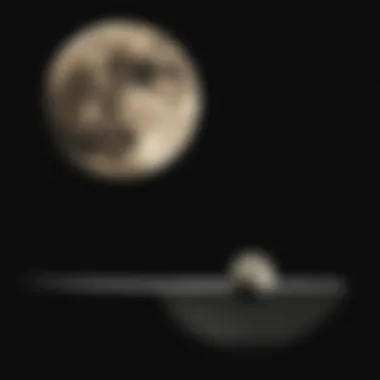
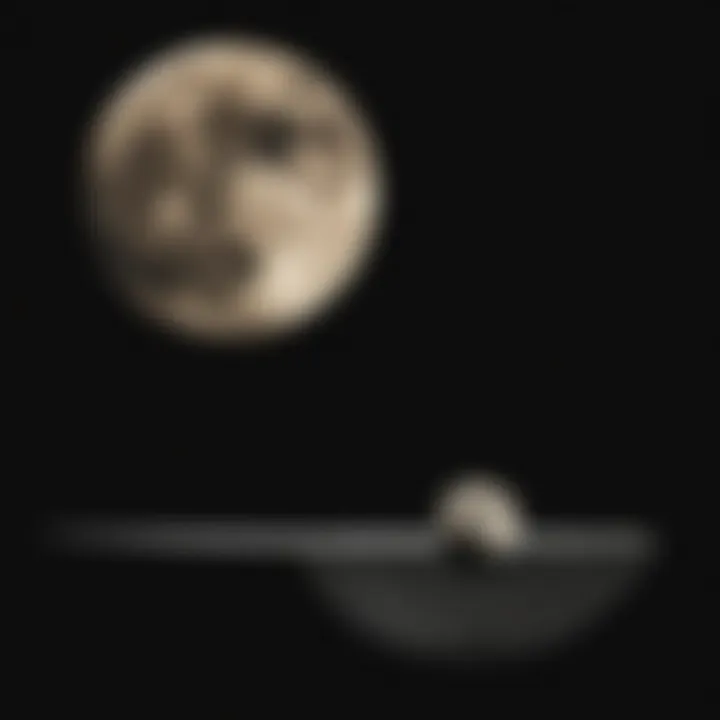
"The Full Moon is a reminder of the connection between nature and human experiences."
Folklore around the Full Moon varies widely but often shares common threads. Understanding these stories gives insight into how humans have viewed celestial bodies throughout history.
The Waning Gibbous Moon
The waning gibbous moon follows the full moon phase and represents a crucial shift in the lunar cycle. During this phase, the visible portion of the moon decreases, but it still illuminates the night sky significantly. Recognizing this phase is important for a deeper understanding of how the moon influences both natural phenomena and cultural practices.
The waning gibbous moon provides a unique opportunity to observe the moon’s surface features. As it transitions away from the full moon, the shadows cast by the lunar landscape create a beautiful and dynamic visual experience. This phase can also evoke discussions about the moon’s impact on various earthly activities, like planting and fishing.
The waning gibbous phase is a reminder of the moon's cycle. It illustrates how change is a part of nature. Understanding this can help us appreciate the passage of time in our own lives.
Identifying the Waning Gibbous
Identifying the waning gibbous moon can be done through simple visual cues. During this phase, the moon appears more than half illuminated but less than fully round. The best way to spot it is to look for the moon in the morning sky shortly after the full moon. It will appear bright and noticeable against the backdrop of dawn.
The waning gibbous is typically visible in the night sky at various heights depending on the time of the month. By observing its shape and brightness, individuals can easily recognize it. Also, the moon appears to move across the sky from east to west, just like the sun.
Cultural Reflections of Waning Gibbous
Culturally, the waning gibbous moon holds substantial meaning across different civilizations. Many cultures see this phase as a time for introspection. The gradual dimming of the moon is thought to symbolize the winding down of activities. This period often encourages individuals to reflect on their past actions and consider changes for the future.
In some traditions, rituals are performed during this phase to release negative energy and make way for new beginnings as the moon progresses toward the new moon. Therefore, the waning gibbous moon is often linked with letting go and preparation.
People create artwork, engage in crafts, and participate in cultural events that correspond with the waning gibbous. This phase prompts discussions about cycles and transitions, making it more than just an astronomical event; it embodies a profound connection to human experiences.
The Last Quarter Moon
The Last Quarter Moon is a critical phase in the lunar cycle. This phase occurs when the Moon has completed three-quarters of its orbit around Earth. As such, it presents a unique opportunity to observe its characteristics and effects. In this section, we will explore what the Last Quarter Moon is and address some common misunderstandings about it.
Understanding the Last Quarter
During the Last Quarter phase, the Moon appears as a half-circle. The left half is illuminated when viewed from the Northern Hemisphere. This illumination is due to the Sun’s light reflecting off the Moon's surface. The Last Quarter typically happens about three weeks after the New Moon. Its duration lasts about one week.
During this time, the Moon’s position makes it easy to see in the night sky. It rises around midnight and sets around noon. This visibility allows for better appreciation of its features. Notably, it provides a crucial moment for astronomers and sky watchers alike to analyze the lunar surface through telescopes.
"The Last Quarter Moon serves as a reminder of the cyclical nature of time and phenomena in our universe."
Misunderstandings of the Last Quarter
There are misconceptions regarding the Last Quarter Moon that often cloud understanding. One common misunderstanding is that it signifies an end or completion. Instead, it is just another phase of the ongoing lunar cycle. Each phase has its unique role and significance.
Another common belief is that the Last Quarter Moon suggests a time for endings only. However, it can also represent a period for reflection and evaluation before moving forward. This aligns with various cultural interpretations where the Last Quarter is seen as an opportunity for preparing for new beginnings.
Lastly, many think that the visibility of the Last Quarter Moon is always the same. In truth, factors such as weather, location on Earth, and the surrounding landscape can impact visibility significantly.
The Waning Crescent Moon
The Waning Crescent Moon represents the final phase of the lunar cycle before the New Moon. This phase is important because it signals the end of the lunar month and prepares the Moon for renewal. Understanding the characteristics and significance of the Waning Crescent can deepen our appreciation of lunar cycles. It serves as a reminder of the constant changes in nature and the cosmic rhythm that governs life on Earth.
Characteristics of the Waning Crescent
The Waning Crescent is the lunar phase where less than half of the Moon is illuminated. Typically, it appears as a thin crescent, fading gradually from the bright side to the complete darkness of the New Moon. The illumination decreases each night, offering a shifting view.
During this phase, the Moon rises later in the night and sets shortly after sunrise. This can make it less visible to observers, as the Moon is often seen just before dawn. Observing the Waning Crescent requires timing and patience. The Moon can be found in the pre-dawn sky, which can provide a peaceful moment for contemplation.
The Waning Crescent is a time of reflection, where one can consider the journey of the moon from bright to dim and back again.
Symbolic Interpretations of the Waning Crescent
Symbolically, the Waning Crescent carries various interpretations across cultures. It is often associated with endings and the release of negativity, making it a suitable time for letting go of old habits or thoughts. In many traditions, this phase encourages individuals to prepare for new beginnings.
The Waning Crescent is seen as a time of introspection. Those observing it often reflect on what they wish to change in their lives. This phase reminds us that every ending can be a precursor to a new beginning. The symbolic nature of this phase can vary depending on personal beliefs and cultural backgrounds, yet its essence remains consistent – the importance of release and reflection before renewal.
Lunar Cycle and Its Duration
The lunar cycle is a fascinating topic that explains how the moon changes its appearance over a period of approximately 29.5 days. Understanding the lunar cycle is significant for many reasons. First, it helps individuals appreciate the beauty and dynamics of the moon. This knowledge also fosters a connection between the celestial body and our earthly experiences. The phases of the moon have influenced cultures throughout history, and knowing these phases aids in comprehending their cultural significance.
Additionally, the lunar cycle can impact various aspects of life here on Earth. For example, it plays a role in tides, agricultural practices, and even some wildlife behaviors. Thus, an understanding of the lunar cycle can enrich one's view of natural phenomena and their interconnections in the ecosystem.
Understanding the Cycle's Length
The cycle begins with the New Moon, marking the start of a new phase. It continues through the Waxing Crescent, First Quarter, Waxing Gibbous, Full Moon, Waning Gibbous, Last Quarter, and finally the Waning Crescent before returning to the New Moon. Each of these phases lasts for approximately 3.7 days, but the total duration from one New Moon to the next is about 29.5 days.
This fraction of a day can be curious. It means that the phases shift slightly every month. For instance, if a New Moon occurs on the first of the month, the next one may happen around the second or third of the following month. This is an essential detail for observing the moon and keeping track of its phases throughout the year.
Factors Influencing the Cycle
Several factors influence the length and visibility of the lunar cycle:
- Earth’s Orbit: The Moon orbits Earth in an elliptical path. This affects how much of the Moon we can see from our vantage point.
- Sunlight Position: The angle at which sunlight hits the Moon changes. This alteration results in varying degrees of illumination seen from Earth.
- Atmospheric Conditions: Weather can significantly alter how we perceive the moon. Clouds can obscure the moon’s visibility, affecting observations.
- Location on Earth: Depending on where one is situated on the planet, the appearance of the moon can differ. For instance, different hemispheres may see different phases more prominently at different times.
Understanding these elements contributes to a more informed observation experience. Accordingly, comprehending the lunar cycle's duration and the factors that influence its visibility enhances one's interaction with the moon. Keep an eye on the night sky and observe the wonders of the lunar phases.
The Scientific Basis of Moon Phases
Understanding the scientific basis of moon phases elucidates how and why these celestial events occur, revealing not just patterns in nature but also the interactions of astronomical bodies. The formation of moon phases is an essential aspect to grasp as it connects the behaviors of the sun, Earth, and the moon together. In this article, we will dissect two pivotal components: the orbital mechanics of the moon and Earth, and the impact of the sun’s positioning.
Orbital Mechanics of the Moon and Earth
The interaction between the moon and Earth is governed by orbital mechanics, which is the study of the movements of celestial bodies through space. The moon orbits the Earth in an elliptical path, taking about 29.5 days to complete one revolution. This cycle determines the varying illumination we see from Earth, thus creating the different phases.
During its orbit, only one side of the moon ever faces Earth due to synchronous rotation. This means we view the moon's changing face as it moves through its phases.
The three main positions of the moon in relation to the Earth and sun that create these phases are:
- New Moon: the moon is between Earth and the sun, and thus its illuminated side faces away from us.
- Full Moon: the Earth is between the moon and the sun, allowing us to see the entire illuminated side.
- Quarter Moons: these occur when the moon is at a right angle to the Earth-sun line, showcasing half of its illuminated side.
Understanding these positions helps clarify how the moon phases are not static but dynamic occurrences that depend on the ongoing dance of these celestial bodies.

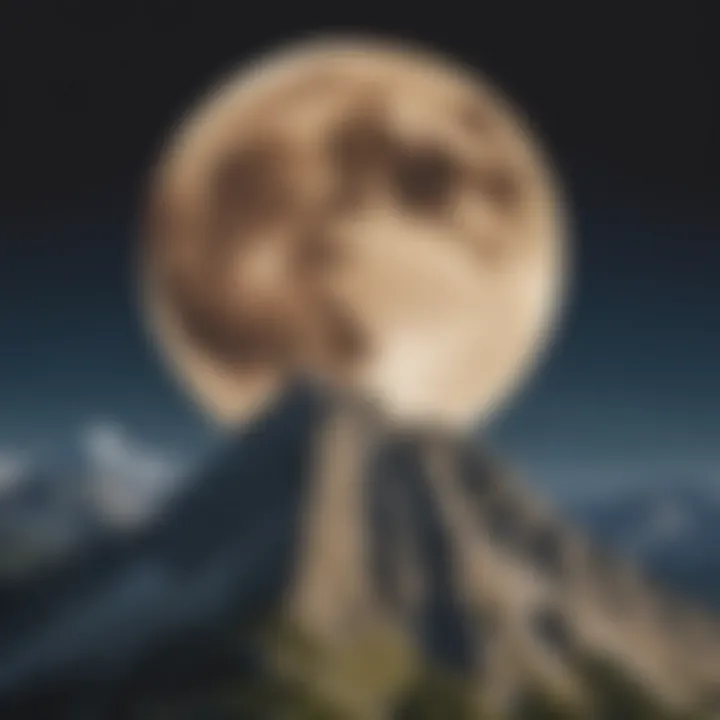
Impact of the Sun’s Position
The sun plays a crucial role in the phases of the moon. It provides the necessary light that illuminates the moon's surface. As the moon moves in its orbit, the angle at which sunlight hits it changes, and this influences the portion of the moon we are able to see from Earth.
Here are some key elements to consider about the sun’s role:
- Sunlight Direction: The angle of sunlight changes as the moon transitions from one phase to another.
- Alignment: The alignment of the Earth, moon, and sun at different phases affects the extent of illumination.
- Earth’s Shadow: In certain cases, such as during a lunar eclipse, the Earth can block sunlight from reaching the moon, giving a different visual experience.
"The moon phases offer a clear representation of the intricate mechanics involving the Earth, moon, and sun, showcasing the harmony of celestial movements."
Understanding these scientific principles gives us a deeper appreciation for the moon's phases, making the observations more meaningful. It enriches not just our knowledge, but offers a window into the complexity of our universe.
Observing the Moon From Earth
Observing the moon is an essential part of understanding its phases and their influence. This subject connects astronomy with our daily lives. The moon acts as a constant presence in our night sky. Its changes can be appreciated by anyone, not just scientists. Watching the moon encourages interest in science among young learners. It also gets people curious about nature.
Best Practices for Moon Observation
Observing the moon can be fun and simple. Here are some best practices to keep in mind:
- Pick the Right Time: It’s best to view the moon on clear nights. Try to gaze during different lunar phases to see how the appearance changes.
- Use Binoculars or Telescopes: While the moon is visible to the naked eye, using binoculars or a small telescope enhances the experience. You can see craters and other details.
- Record Your Observations: Keeping a journal of your moon observations can be helpful. Note the phase and any features you see. This practice can deepen your understanding.
- Learn the Names of Features: Familiarize yourself with terms like craters, seas, and mountains. Knowing them adds more depth to your observation.
Technology in Lunar Observation
Modern technology has greatly improved how we observe the moon. Here are key elements to consider:
- Apps for Sky Observations: There are many apps available that help identify moon phases and celestial events. Some popular ones are SkyView and Star Walk.
- Telescopes with Cameras: Certain telescopes connect with cameras. This allows you to capture images of the moon. These images can be shared with friends or on social media.
- Live Streams from Observatories: Various observatories live-stream their images of the moon. This can be a great way to see the moon without leaving home.
Observing the moon enhances one’s appreciation for astronomy and the beauty of our universe.
Taking advantage of technology and adopting best practices will elevate the experience of observing the moon. Whether through a telescope, app, or simple gaze at the night sky, anyone can be captivated by its beauty.
Cultural Representations of Moon Phases
The phases of the moon have held significant meaning in many cultures throughout history. Understanding these representations provides insight not only into astronomy but also into human creativity and belief systems. The moon cycles influence various aspects of life, from agriculture to spirituality. By exploring how different societies perceive the moon, we can appreciate its universal impact and significance.
Moon Phases in Various Cultures
Different cultures have their own stories and meanings associated with the moon's phases. For example:
- Chinese Culture: The full moon is a symbol of family reunions during the Mid-Autumn Festival. Traditional mooncakes are shared among families to celebrate this time.
- Native American Tribes: Many tribes name full moons after seasonal events. For instance, the October full moon is called the "Hunter's Moon," indicating the time of year for hunting and gathering food.
- Hinduism: In Hindu culture, the moon is personified as the god Chandra. Festivals like Karva Chauth involve women fasting until they can see the moon.
- Islam: The lunar calendar plays a critical role in determining the months for fasting during Ramadan and observing Islamic holidays.
Each of these cultural interpretations illustrates how the moon influences life, spiritual beliefs, and seasonal activities.
Art and the Moon: A Cross-Cultural Exploration
Art serves as a powerful reflection of cultural values and beliefs, and many artists depict the moon in their works. From ancient civilizations to modern-day artists, the moon appears in various forms.
- Visual Arts: Artists often use the moon as a motif to convey emotions or themes. For example, Vincent van Gogh's "Starry Night" features a stylized moon, emphasizing the emotional depth of the night sky.
- Literature: Poets and writers frequently use the moon in their narratives, symbolizing beauty, longing, and mystery. For instance, the moon often appears in romantic poems, representing unattainable ideals.
- Music: The moon also finds its way into song lyrics, inspiring soulful melodies that evoke feelings related to night and dreams.
"The moon is a poetic muse, inspiring creativity across all forms of art."
In summary, exploring cultural representations of moon phases enriches our understanding of the moon's impact on humanity. From celebrations to artistic expressions, the moon transcends boundaries, linking us all through time and space.
Mythology and Folklore Surrounding the Moon
The moon has always held a significant place in mythology and folklore across nearly every culture. It has inspired countless tales, from creation myths to stories of gods and goddesses. This section delves into the importance of understanding these mythological narratives, revealing how the moon's phases have influenced cultures and societies throughout history.
By examining these stories, we can see that moon phases are not just astronomical events; they carry profound cultural meanings. They provide insight into how ancient peoples understood their world, explained the natural phenomena, and created moral lessons through storytelling. In this light, the topic of moon mythology and folklore becomes crucial, as it helps unravel the complex relationship humans have had with the night sky.
"The moon shines different for each culture, each carrying unique tales and wisdom."
Legends Across Different Cultures
Legends surrounding the moon vary widely, yet many share common themes. For instance, in Greek mythology, Selene is the goddess of the moon. She symbolizes beauty and is often depicted driving a chariot across the night sky. Similarly, Hindu mythology describes the moon as Chandra, a significant figure in many creation stories. The consistent presence of a lunar deity reflects the moon's importance in various societies.
In Native American cultures, stories about the moon often describe a connection to nature and agriculture. For example, some tribes believe the moon affects the growth cycles of plants. This conveys respect for the moon and an understanding of its influence on daily life.
Consider the following as key points about lunar legends:
- Divine Figures: Many cultures personify the moon as a goddess or god, illustrating its revered status.
- Cycles and Seasons: The moon's phases inform agricultural practices, as observed by various Native American tribes.
- Mythical Creatures: Some legends feature creatures that embody lunar qualities, adding depth to the moon's characterization in folklore.
Significance of the Full Moon in Folklore
The full moon, in particular, holds a prominent role in many folklore tales. Often, it is associated with supernatural events or changes in behavior. In European folklore, the full moon is linked to werewolf legends, signifying transformation and mystery. These tales contain strong moral lessons about control and the duality of human nature.
In contrast, many Asian cultures view the full moon as a time for celebration. The Mid-Autumn Festival in China celebrates the harvest, with families gathering to feast under the full moon. This illustrates the full moon's connection to community and abundance.
Key significances of the full moon include:
- Change and Transformation: Many cultures associate the full moon with supernatural occurrences, mirroring themes of change.
- Celebration of Harvest: Festivals celebrate the harvest under the full moon, marking a time of abundance and gratitude.
- Mythical Connections: Stories often link the full moon with gods and creatures, enhancing its mystical appeal.
Understanding the mythology and folklore surrounding the moon enriches our appreciation of its phases. It underscores the interconnectedness of nature and human culture, revealing how celestial patterns can shape stories, traditions, and communities.
The End: The Moon's Influence on Earth
The moon plays a pivotal role in various natural processes on our planet. Its influence stretches beyond mere aesthetics, shaping environmental systems and cultural practices. Understanding this influence provides insights into the interconnectedness of celestial bodies and earthly life.
The Moon's Role in Tides and Ecosystems
The gravitational pull of the moon is a primary factor in the creation of tides in our oceans. As the moon orbits the Earth, its gravity causes water to bulge, resulting in high tides. Conversely, when the moon is positioned at a right angle relative to the Earth and the sun, low tides occur.
These tidal movements are crucial for marine ecosystems. They create a dynamic environment that supports various life forms. For instance, many species, such as crabs and starfish, depend on tidal changes for feeding and reproduction. Additionally, the rhythmic rise and fall of tides helps to circulate nutrients in coastal waters, fostering rich habitats essential for fish and other marine creatures.
Look at the moon's effect on higher tides during certain lunar phases. Full moons and new moons often lead to what are known as spring tides, which are the strongest tides occurring twice a month. This cyclic pattern plays a vital role in marine life cycles.
"The moon is more than just a celestial body; it is a significant factor in our planet's ecological balance."
Encouraging Interest in Astronomy and Science
With the moon's influence visible to all, it serves as a gateway to fostering interest in astronomy and science. Observing lunar phases can spark curiosity in children and adults alike. When young learners look up at the night sky, they may wonder about what lies beyond our atmosphere, leading to explorations of space, planets, and stars.
Engaging with the moon can be as simple as observing its phases or exploring its cultural impact through history. Schools and educational programs may include activities like moon journaling or creating moon phase models to aid this interest.
Furthermore, this engagement with the moon can encourage skills such as critical thinking and observation. These skills are essential not only in science but across disciplines. By learning about the moon, individuals may become more aware of the principles of science and nature, thereby encouraging deeper studies in STEM fields.







